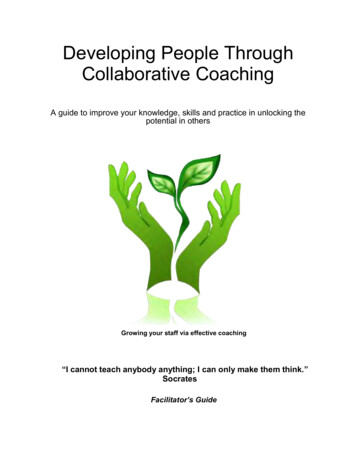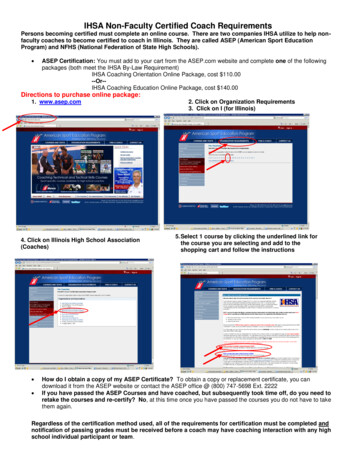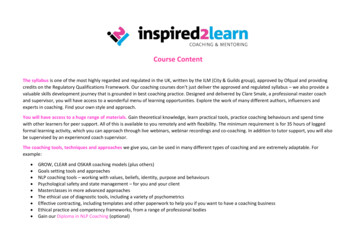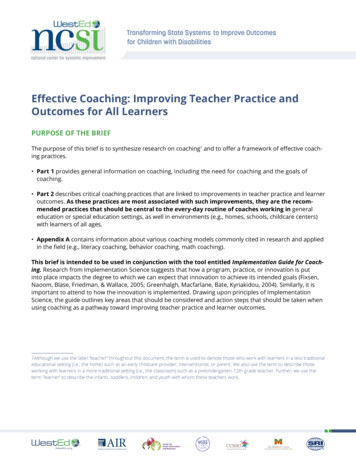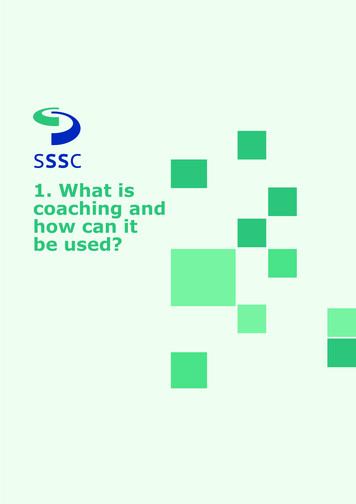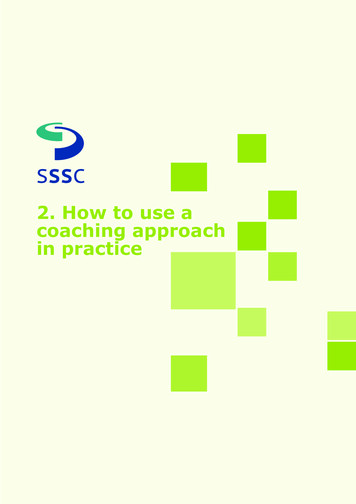
Transcription
The current issue and full text archive of this journal is available /coachingandmentoring/International Journal of Evidence Based Coaching and MentoringVol. 8, No. 2, August 2010Page 27Motivational Coaching: A Functional Juxtaposition of Three Methods for HealthBehaviour Change: Motivational Interviewing, Coaching, and Skilled HelpingCourtney Newnham-Kanas, Faculty of Health Sciences, University of Western Ontario, CanadaDon Morrow, Faculty of Health Sciences, University of Western Ontario, CanadaJennifer D. Irwin, Faculty of Health Sciences, University of Western Ontario, CanadaEmail: jenirwin@uwo.caAbstractThe purpose of this paper was to explore the unique qualities/characteristics/components of the Co-Activecoaching model compared to Motivational Interviewing and Egan’s Skilled Helper Model. Six questionspertaining to the creation, purpose, and process of the therapeutic alliance; and the relationship betweenpractitioner and client were used to guide comparisons. Given the similarities among all three methods, itcannot be said that any of them are necessarily distinctive in their core principles or tenets. Instead, theiruniqueness lies in the way that they are packaged and delivered. A model of Motivational Coaching,informed by this study’s comparative analysis of the three models/method analyzed in this paper, ispresented. Our intent is to distil into one framework the key components of three important and overlappingmethods used in working toward behavioural changes.Keywords: Co-Active life coaching; Motivational Interviewing; Egan’s Skilled Helper Model; BehaviourchangeIntroductionLife coaching is a relatively new practice that has gained attention, recognition, and criticism froma variety of different professions. Over the last ten years it has been utilised in health field in areas such asdiabetes (Joseph, Griffin, Hall, & Sullivan, 2001); fitness (Tidwell, Holland, Greenberg, Malone, Mullan, &Newcomer, 2004); mental health (Grant, 2003); obesity (Newnham-Kanas, Irwin & Morrow, 2008; vanZandvoort, Irwin & Morrow, 2008; 2009); and cancer (Brown, Butow, Boyer, & Tattersall, 1999) to name afew (for a full overview of coaching-related health studies see Newnham-Kanas, Gorczynski, Morrow &Irwin, 2009). Traditionally, the prevailing trend and professional training in health care has relied onproviding patients and clients with information about health (together with the assumed client impact-factorof professional status); specifically, health information has been directed toward primary care and thetreatment of illness to the detriment of a complementary focus on prevention (see Elder et al., 1999). Thusthe use of coaching and other motivational, behavioural change methods is an important, emergent process.Perhaps the most recent partnership example of coaching with health care is that of the Institute ofCoaching; in 2009, the Institute became allied with the McLean Hospital, a Harvard Medical Schoolaffiliate, a fortuitous merger demonstrative of the perceived health impacts of coaching. There arenumerous coaching training schools throughout North America each with their own method and techniques.However, most research using coaching as a treatment or intervention has not focused on a specificcoaching method. Consequently, there is a discernible inability to assess the reliability and validity of the
The current issue and full text archive of this journal is available /coachingandmentoring/International Journal of Evidence Based Coaching and MentoringVol. 8, No. 2, August 2010Page 28generic use of “coaching” as a treatment or intervention for any behaviour change. Over the past two years,three studies assessing coaching’s impact on obesity (Newnham-Kanas et al., 2008; van Zandvoort, Irwin,& Morrow, 2008; 2009), one on physical activity (Gorczynski, Irwin, & Morrow, 2008), and one onsmoking cessation (Mantler, Irwin, & Morrow, 2010) have evaluated one specific method of coaching, thatof Co-Active coaching (the form of coaching taught by the International Coach Federation-accreditedCoaches Training Institute) as a treatment for behaviour change. The reported results of these studies attestto the utility of this particular coaching paradigm in effecting powerful health behaviour changes.The purpose of this paper is to explore the unique qualities/characteristics/components of CoActive coaching (hereafter referred to as coaching) compared to Motivational Interviewing (Miller &Rollnick, 2002) and Egan’s Skilled Helper Model (SHM) (Egan, 2006). Motivational Interviewing (MI)was selected for comparison with Co-Active coaching due to our perception of their similarities, andexpressed interest by health professionals who have shared with us their inability, to date, to define thedifference between MI and coaching and/or have experienced difficulty applying MI’s principles (also seeMesters, 2009). Upon submission of a recent manuscript that utilised Co-Active coaching as a treatment,one reviewer highlighted the overwhelming similarities between coaching and Egan’s SHM (Egan, 2006).Our own work using the Co-Active model along with MI has led us to explore the commonalities of thesechange processes. By comparing and contrasting these behaviour change approaches, this analysis seeks tocreate clarity via a newly-derived model of motivational coaching that amalgamates the central threadsfrom Egan’s SHM, the MI principles, and the Co-Active coaching method. While there is not a substantialbody of literature pertaining to the explicit use of Egan’s SHM, our experience as researchers and coachpractitioners suggests considerable merit in the elements and principles inherent in Egan’s SHM. Ourexperientially and research grounded perspective is that coaching works quickly and powerfully; clearly,practitioners who utilize MI and Egan’s SHM along with researchers who have assessed their effectivenesswould attest to their important impact as well (references and study summaries are presented in theCoaching, MI, and Egan’s model/method Effectiveness section below). Health practitioners – dieticians,nurses, nurse practitioners, diabetes’ educators, and nutritionists among many other health changeprofessionals – are in need of potent techniques that can be employed to motivate their clientele towardimpactful, healthful behaviour change (e.g. Goldberg & Gournay, 1997). This paper provides a synthesis ofthe three models/techniques in order to close the gap on this practical need on the part of health carepractitioners.MethodMotivational Interviewing (Miller & Rollnick, 2002) and Egan’s SHM (Egan, 2006) werecompared to coaching descriptively with the following six questions guiding the comparison’s components: How is the therapeutic alliance created; what is the purpose of the alliance?How is the client perceived by the coach/counsellor?How is the agenda determined for individual coaching/counselling sessions?How is each method/model sensitive to the needs of the client; in short, in what way/s is themethod/model client-centered?What aspects of the client’s lived experiences are involved in the coaching/counsellingsession?What process is used by the coach/counsellor to assess the client’s need and/or readinessfor change?
The current issue and full text archive of this journal is available /coachingandmentoring/International Journal of Evidence Based Coaching and MentoringVol. 8, No. 2, August 2010Page 29These six questions have been addressed in the written explanation of the three models/methods (below)providing clear points of reference for the comparison between coaching and MI and coaching and Egan’sSHM. The following primary sources were used for describing the models/method presented throughout thepaper: Egan, 2006; Miller and Rollnick, 1995; 2002; and Whitworth, Kimsey-House, and Sandahl, 1998;2007.In service of transparency, it should be noted that while the authors of this review are doctorallytrained in health sciences, we also received supplementary coaching training through The Coaches TrainingInstitute (CTI). The authors have previously conducted research assessing the effectiveness of Co-Activecoaching as a behaviour change treatment (e.g. Newnham-Kanas, Irwin & Morrow, 2008; Gorczynski,Irwin, & Morrow, 2008; Mantler, Irwin, & Morrow, 2010; van Zandvoort, Irwin, & Morrow, 2008; 2009).We also want to note that there has been no collaboration, sponsorship, or professional affiliation with CTI.Each model/method is described briefly and there follows an introduction to current research usingeach model/method as a behaviour change treatment. A discussion concerning the similarities anddifferences of MI and Egan’s SHM compared to coaching is provided and amplified by summary Table 1.The concluding comments include a derivative model incorporating the functional features from each of thethree models.Table 1 - Comparison Among Techniques Utilised by MI, Coaching, and EganModel/MethodMotivational InterviewingCo-Active Life CoachingEgan’s Self-Helper ModelTherapeuticAllianceIn MI, motivation can arise fromthe interaction between twopeople. The client is viewed as anexpert and the counsellor isviewed as a catalyst inaccelerating change by aiding theclient in clarifying their reasonsfor change and helping themcreate a change plan.It is presumed by counsellors thatthe client is able to increaseintrinsic motivation and providesolutions to serve his/her owngoals and values in order tofacilitate change.Referred to as the Designed Alliancewhereby the coach and client create arelationship that fits their working andlearning styles and is respectful of thecommunication approach that worksbest for them. The coach is viewed asthe catalyst for change and the powerof coaching is in the designed alliance.The client and counselloralliance is co-constructed bythe client and counsellor. Eganbelieves that change isfacilitated through therelationship itself, the work thatis done, and the outcomes thatare achieved.Coaching is based on the fundamentalprinciple, from the coach’s point ofview, that nothing is wrong with theclient and that the client is neitherbroken nor in need of fixing but isnaturally creative, resourceful, andwhole (NCRW). Clients are recognizedas being the person who knows what isbest for them and have the answers orare capable of finding the answers theyneed.Determined by the clientCounsellors do not view theirclients as victims but as equalcontributors that influence theprocess of their change.Involves client’s whole life.Involves client’s whole lifewith specific emphasis onsocio-cultural influences.“Dance in the moment” refers to theflexibility and willingness of the coachto go in the client’s direction to meetthe needs of the client. It involveslistening at a very deep level toEgan’s model provides greatflexibility for counsellors tomove with clients depending onthe moment.View of ClientAgenda SelectionDetermined by the clientAspect of client’slife involvedFocused on specific aspects of aclient’s life. Impact of change onthe client’s whole life notstressed.Counsellors move with theirclients and in order to maintainpositive therapeutic outcomes,counsellors must “roll withresistance” rather than challengeFlexibility ofcoach/counsellorDetermined by the client
The current issue and full text archive of this journal is available /coachingandmentoring/International Journal of Evidence Based Coaching and MentoringVol. 8, No. 2, August 2010Page 30it. Resnicow and colleagues(2002) stated that MI is more likea dance rather than a wrestlingmatch.determine what is most important forclients based on their agenda.Two phases: 1) Buildingmotivation for change; and 2)Strengthening the commitment tochange.Referred to as reflective listening.The key to this technique is howthe counsellor responds to whatclients say. The essence of thisform of listening is about makinga guess as to what the client reallymeans.Three principles: 1) Fulfillment; 2)Balance; and 3) Process.Self-ManagementMI counsellors work diligently toself-manage by reconnecting withclients if they slip into theirinternal dialogue. Counsellorswill provide advice if it isrequested or permission is grantedby clients and it is viewed asaiding clients to meet their goals.Self-management is about awarenessand recovery. It is the role of coachesto become aware of when they aredistracted and it is their responsibilityto reconnect back with the client.Coaches manage the urge to provideopinions and advice in situations suchas these in order to keep focus on whatbest serves the interest of the client.However, advice is provided ifrequested or in service of the client’sgoals.IntuitionBased on reflective listening, thecounsellor’s intuition is essentialin determining what the clientreally means. It is not implicitlystated or defined in MI, but basedon the coaching definition, it ispresent in both phases. Thecounsellor’s intuition isimperative in determiningwhether the client is ready tomove from phase I to phase II ofthe MI method. A client may notalways be aware of whether theyare capable of making the leapinto action – counsellor intuitionand expertise are heavily relied onduring this transition.A coach’s intuition is incrediblyvaluable to the coaching relationship.When coaches are able to fully trusttheir intuition, it provides anopportunity for clients to explore ideas,thoughts, and feelings that may nothave been conscious to the client. Byexperiencing the coach’s intuition,clients may in turn connect with agreater awareness to their ownintuition.Process used tofacilitate changeListeningIncludes three levels of listening:Level I – coach’s internal dialogueLevel II – focused listening on theclientLevel III – wide range of listening thatpicks up on clients’ emotion, bodylanguage, and the surroundingenvironment.Three stage model: 1) What’sgoing on; 2) What solutionsmake sense for me; and 3) Howdo I get what I need or want.Empathic listening is used inthe Egan model and focuses onattending, observing, andlistening to the client – a wayof “being with” the client. Egancontends that this form oflistening is driven by the valueof empathy and is a way for thecoach to get inside the client’sworld. In this model, thecounsellor’s internal dialogueis referred to as the “internalconversation” of the counsellor.Counsellors are constantly selfmanaging and are actuallyaware of when their ownthoughts, feelings, orjudgements have been triggeredby something the client hassaid. Advice giving is viewedas robbing clients of selfresponsibility. Therefore,counsellors do not set out toprovide opinions and/or adviceunless it is in service of orrequested by the client.Egan’s model, like coaching,relies heavily on thecounsellor’s intuition. InEgan’s model, intuition isviewed as a form of selfconsciousness and refers to itas a virtual second channel.This second channel providesinformation to coaches on theirown nonverbal behaviour,feelings, and emotions.
The current issue and full text archive of this journal is available /coachingandmentoring/International Journal of Evidence Based Coaching and MentoringVol. 8, No. 2, August 2010Page 31FindingsModel/Method SummaryCo-Active coaching - The Co-Active model (Whitworth, Kimsey-House, and Sandahl, 1998; 2007)graphically depicts the essence of the coaching training delivered by its creators. The Co-Active portion ofits title refers to the collaborative interaction between coach and client based on the assumption of strengthand capability of the client to determine what is best for him or her. It is a directed and structuredconversation because it is emboldened by respect, openness, compassion, empathy, and authenticity onbehalf of the coach and client. The coach’s role is to empower clients to make choices based on theirvalues; to hold clients accountable for their decisions and actions; and to support clients either in selflearning and/or moving forward towards their goals. This model uses three life principles as forms ofcoaching; the structure utilised is dependent on the client’s needs. Fulfilment coaching is used to explorewhat it means for each client to live true to his/her values (fulfil those values) in his/her life; balancecoaching is selected to provide alternative perspectives on recurring issues (ones where the client is stuck oroverwhelmed) and to develop potential, planned, alternative courses of action to which a client can commit;and process coaching is chosen to address the internal emotional experience of the client and what ishappening within him/her in the way s/he experiences life at the present moment in time.Motivational Interviewing - Motivational interviewing (MI) represents about a quarter century ofan interview style that is designed to resolve client ambivalence in service of moving toward change(Arkowitz, Westra, Miller, & Rollnick, 2008). Historically this is a significant paradigm shift from othercounselling techniques. MI focuses on the behaviour of the counsellor as a key element in creating arelationship within which clients can accomplish change easily. The core of learning in MI is represented inthis particular focus. MI is considered more of a style of therapy grounded on a set of principles (expressempathy, develop discrepancy, roll with resistance, and support self-efficacy) rather than a set of particulartechniques (Miller & Rollnick, 1995). As a definition, MI’s founders state that it is “a client-centered,directive method for enhancing intrinsic motivation to change by exploring and resolving ambivalence”(Miller & Rollnick, 2002, p.25).Motivational interviewing is characterized by the following seven key points (Rollnick & Miller,1995):1) change must be elicited by the client and not imposed by the counsellor;2) clients are responsible for articulating and resolving their own ambivalence;3) counsellors do not persuade their clients to resolve ambivalence;4) counsellors generally take a gentle approach that elicits change from clients;5) counsellors are focused in helping clients examine and resolve ambivalence;6) readiness to change fluctuates depending on the interpersonal interaction between counsellor andclient;7) the counsellor/client relationship is a partnership where the counsellor respects the client’sautonomy.The founders of this method (Miller and Rollnick) have conceptualized the MI process in twophases. Phase I centres on building motivation for change. Some clients enter counselling alreadyconvinced that there are multiple reasons to change. These clients may have little use for Phase I except toclarify those reasons from the client’s perspective. Clients who are not as clear about their reasons for
The current issue and full text archive of this journal is available /coachingandmentoring/International Journal of Evidence Based Coaching and MentoringVol. 8, No. 2, August 2010Page 32change first must determine how important change is to them as well as their confidence that they canactually make the changes needed to meet their desired goals.Phase II focuses on strengthening the commitment to change. This phase is entered when clientshave reached a point of readiness, itself the essence or sine qua non of MI, and the counsellor recognizesthat change should be initiated. Clients are expected both to elicit and be explicit about what they want andplan to do. This change plan involves: 1) setting goals; 2) considering change options; 3) arriving at a plan;and 4) obtaining commitment. Commitment to a change plan concludes the cycle of MI. This method is astyle of counselling and psychotherapy which stems from a flexible approach that can be used on its own, inconjunction with another approach, or as an adjunct to another therapy (Arkowitz et al., 2008).Table 2 - Background Comparison of the Three Models MI, Coaching, and Egan’s SHMModel/MethodMotivational Interviewing Co-Active Life CoachingEgan’s Self-Helper ModelFoundersDr. William R. Miller and Dr.Stephen Rollnick1983There is not a standardizedtraining package or trainingrequirement to be considered aMotivational Interviewer.Training programs that areoffered varying in the numberof days and hours involved intraining. This form of trainingdoes appear to be gearedtowards health professionals.Laura Whitworth and Karen and HenryKimsey-House1992Prerequisites for certification includecompletion of the first four Co-Activecore coaching courses – Fundamentals ofCo-Active coaching, Fulfillment,Balance, and Process. Certificationincludes the completion of a six-monthcertification program offered by theCoaches Training Institute along with anestablished relationship with a CertifiedProfessional Co-Active Coach (CPCC), aProfessional Certified Coach (PCC) or aMaster Certified Coach (MCC) from theInternational Coaching Federation. Aftersuccessful completion of the programstudents are eligible to take the writtenand oral certification exam. Anyindividual regardless of their previoustraining or occupation may apply for thecourse work and certification program.Dr. Gerard EganTo elicit behaviour change byhelping clients to explore andresolve ambivalence (Miller &Rollnick, 1991).To assist clients in creating the life theywant by forwarding the action anddeepening the learning throughdiscovery, awareness, and choice(Whitworth, Kimsey-House, & Sandahl,2007).Year DevelopedTraining RequiredPrimary Goal1986There is not a standardized trainingprogram for Egan’s Helper Model.Some universities offer this training aspart of their psychotherapy orcounsellor curriculum. For example,the Kelowna College of ProfessionalCounselling in British Columbia offera number of courses in their programthat emphasize solution focusedmodalities and the works of Egan areused in some of the curriculum. TheUK College of Holistic Training offersa certificate in Skilled HelperCounselling and an online coachingprogram that is available tointernational individuals. The programlasts anywhere from one to threemonths.Egan training does appear to be gearedtowards individuals enrolled in acounselling program. However,programs do exist without anyprerequisites.To aide clients in managing theirproblems in living more effectivelyand develop life-enhancing un-usedopportunities more fully (Egan, 2006).Egan’s Skilled Helper Model (SHM) - Egan’s SHM (Egan, 2006) is described as a client-centeredand systematic approach to ‘helping’. It is typified more as a framework for conceptualizing the helpingprocess than a theoretically-derived model. Metaphorically, Egan’s SHM is compared to a map in that themap helps the skilled helper to know where to go with a client; the intended goals of the model are to helppeople become better at helping themselves in their everyday lives and/or manage their problems in livingmore effectively and develop unused opportunities more fully. The role of clients is to commit themselvesto the helping process and capitalize on what they learn from the helping sessions to manage the challenges
The current issue and full text archive of this journal is available /coachingandmentoring/International Journal of Evidence Based Coaching and MentoringVol. 8, No. 2, August 2010Page 33of their life more effectively. The model emphasizes empowerment and consists of three stages each withits own fundamental question for clients to consider: 1) what’s going on?; 2) what solutions make sense forme?; and 3) how do I get what I need or want? Within each stage, specific tasks are provided to answer theunderlying questions but these tasks are not restricted to the stage under which they are described. In stageI, clients are provided with the opportunity to share their story. This creates an opportunity for thecounsellor to work with the client to develop new perspectives and reframe his/her story. In stage II,counsellors help clients discover possibilities that will lead to a clearer future; and stage III is gearedtowards action. Egan’s SHM has undergone a variety of iterations (1975; 1982; 1990; 2006); within thispaper, coaching will be compared to its most recent version (2006). Table 2 above provides keycomparative and background information regarding each model/method.Coaching, MI, and Skilled Helper Model/Method EffectivenessAs mentioned in the introduction, life coaching is a relatively new area of research with respect toits application in the health field. Over the past two years, four studies have evaluated and reported theeffectiveness of Co-Active coaching as a behaviour change treatment in the areas of obesity, physicalactivity, and smoking cessation (Newnham-Kanas, Irwin & Morrow, 2008; Gorczynski, Morrow & Irwin,2008; Mantler, Irwin & Morrow., 2010; van Zandvoort, Irwin, & Morrow, 2008; 2009). Although coachingresearch is in its infancy, MI has been used for several years as a successful intervention in research with aspecific emphasis on addictions or addictive behaviours primarily associated with alcohol use (Brown &Miller, 1993; Miller, 1998; Miller, Yahne, & Tonigan, 2003). However, more recently, MI has been utilisedto address health behaviours and conditions with continued success in areas such as: smoking (Butler,Rollnick, Cohen, Bachman, Russell, & Stott, 1999); diet (Berg-Smith, Stevens, Brown, Van Horn,Gernhofer, Peters, et al., 1999); physical activity (Harland, White, Drinkwater, Chinn, Farr, & Howel,1999); medical screening (Taplin, Barlow, Ludman, MacLehose, Meyer, Seger et al., 2000); diabetescontrol (Doherty, Hall, James, Roberts, & Simpson, 2000); and medical adherence (DiIorio, Resnicow,McDonnell, Soet, McCarty, Yeager, 2003). Similar to MI, Egan’s SHM has been applied to specialist clientpopulations and contexts with reported success with: sexual abuse (Hall & Lloyd, 1993); studentcounselling (Stein, 1999); counselling primary health care (Hudson-Allez, 1997); and training nurses andother health professionals (Arnold & Boggs, 1995; Freshwater, 2003). Despite the fact that Egan’s SHMhas been used with specialized populations, there was no research located that sought to assess itseffectiveness specifically as a behaviour change intervention (Egan’s SHM is primarily cited as a viabletreatment method in textbooks and handbooks that are aimed at treating specialized populations such asvictims of sexual abuse). The results from studies that assessed coaching’s and MI’s findings regardingbehaviour changes are summarized in Table 3 below.
The current issue and full text archive of this journal is available /coachingandmentoring/International Journal of Evidence Based Coaching and MentoringVol. 8, No. 2, August 2010Page 34Table 3 - Summary of Study Results Utilizing MI, Coaching, or, Egan in Health Behaviour InterventionsAuthorsYearPublishedBerg-Smith, S. M., Stevens,V. J., Brown, K. M., VanHorn. L., Gernhofer, N.,Peters, E. et al.Butler, C.C., Rollnick, S.,Cohen, D., Bachman, M.,Russell, I., & Stott, N.1999DiIorio, C., Resnicow, K.,McDonnell, M., Soet, J.,McCarty, F., Yeager, K.20031999Doherty, Y., Hall, D., James, 2000P.T., Roberts, S.H., &Simpson, J.Gorczynski, P., Morrow, D.,& Irwin, J.D.2008Harland, J., White, M.,Drinkwater, C., Chinn, D.,Farr, L., & Howel, D.1999Miller, W.R., Yahne, C.E., & 2003Tonigan, S.J.Newnham-Kanas, C., Irwin,J.D., & Morrow, D.2008van Zandvoort M., Irwin, J.D., & Morrow, D.2009ParticipantsResultsYouth and adolescents Overall, the intervention successfully re-engaged participants(13-17 yrs) dealingin personalized goal setting, and appeared to increase andwith dietary issues.renew adherence to the DISC dietaryguidelines.Cigarette smokersSignificantly more patients in the motivational consulting(28-55 yrs).group reported not smoking in the previous 24 hours(P 0.01), delaying their first cigarette of the day more thanfive minutes after waking (P 0.01), making an attempt toquit lasting at least a week during follow-up (P 0.04), andbeing in a more ready stage of change (P 0.05).Women with HIV.Mean scores on ratings of missed medications were lower forparticipants in the intervention group than those in the controlgroup. Although there were no significant differences in thenumber of medications missed during the past 4 days,participants in the MI group reported being more likely tofollow the medication regimen as prescribed by their healthcare provider.Health care workers. This was a feasibility study that examined whether skills incounselling behaviour change may help staff working indiabetes care to facilitate self-management in people withdiabetes. The findings suggest that the stages of changemodel, motivational interviewing and behavioural techniquesare relevant to work in this area.Inactive youth (12Physical activity increased for one participant while the other14).participants’ physical activity remained unchanged. Nosignificant changes occurred in self-efficacy, social support,and perceived behavioural control with specific regard tobecoming more physically active.Adults (40-64 yrs)More participants in the intervention group reported increasedphysical activity scores at 12 weeks than controls (38% v 16%,difference 22%, 95% confidence interval for difference 13% to32%), with a 55% increase observed in those offered sixinterviews plus vouchers. Vigorous activity increased in 29%of intervention participants and 11% of controls (difference18%, 10% to 26%).In- and outpatientsContrary to prior reports, MI showed no effect on drug useentering publicoutcomes when added to inpatient or outpatient treatment,agencies for treatment although both groups showed substantial increases inof drug problems.abstinence from illicit drugs and alcohol.Obese adults (35-5
life involved Focused on specific aspects of a client’s life. Impact of change on the client’s whole life not stressed. Involves client’s whole life. Involves client’s whole life with specific emphasis on socio-cultural influences. Flexibility of coach/counsellor Cou

